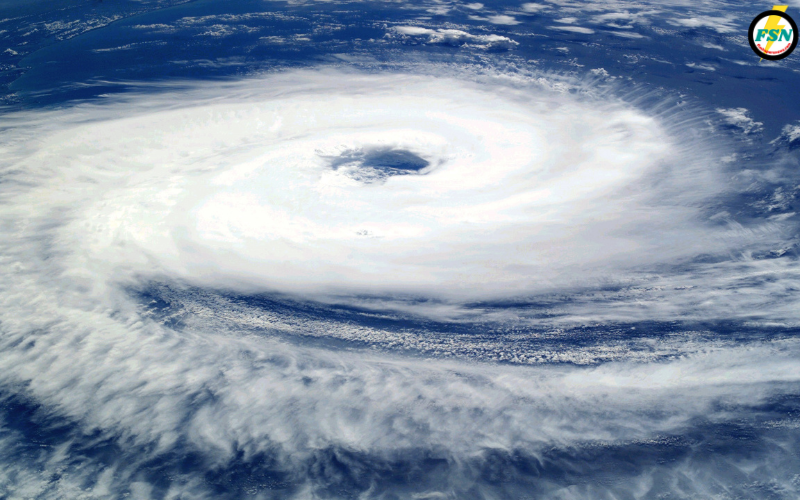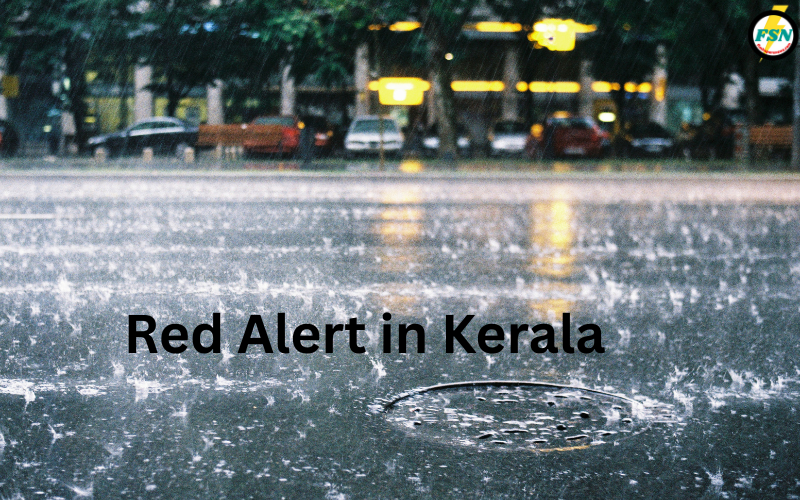Red Alert in Kerala as 5 Districts Hit by Cyclone Wipha Intensifies — IMD Issues Heavy Rainfall Warning

The Indian Meteorological Department (IMD) has issued a Red Alert in Kerala, as Cyclone Wipha continues to gain strength in the Arabian Sea. Five districts have already been severely impacted, with torrential rains and heavy winds lashing the region. The alert has triggered widespread precautionary measures by the government and local authorities to ensure public safety. With the monsoon season intensifying and Cyclone Wipha’s unpredictable nature, the people of Kerala are urged to remain indoors and stay updated through official channels.
The state, known for its lush landscapes and serene backwaters, is now facing the harsh wrath of nature. Schools have been shut, transportation is disrupted, and emergency services are on high alert. The disaster management teams are coordinating with local panchayats to evacuate vulnerable areas and provide relief to those affected. The situation remains tense as meteorological predictions suggest continued heavy downpours and wind gusts over the next 72 hours amid the ongoing Red Alert in Kerala.
The announcement of a Red Alert in Kerala is not merely a weather warning—it is a call to immediate and coordinated action across all levels of society. The IMD has predicted extremely heavy rainfall in excess of 204 mm in some regions, with thunderstorm activity and gusty winds exceeding 65 km/h. These adverse weather conditions, coupled with Kerala’s geography of hills, rivers, and coastal plains, heighten the risk of flash floods, landslides, and waterlogging.
Cyclone Wipha formed rapidly in the Arabian Sea and has taken a trajectory that puts Kerala’s coastline in its direct path, necessitating a Red Alert in Kerala. While the cyclone has not yet made landfall, its outer bands are already impacting the state, particularly in the southern and central districts. The government has urged fishermen to stay ashore and coastal residents to move to higher ground. The Indian Navy, Coast Guard, and disaster response units are monitoring the situation and are on standby for emergency rescues.
The gravity of the Red Alert in Kerala has prompted Chief Minister Pinarayi Vijayan to convene high-level meetings with the State Disaster Management Authority. Emergency funds have been released to district collectors, and essential supplies including food, medicine, and fuel are being stocked in critical areas. Relief camps have been opened in schools, community halls, and religious institutions for those displaced.
Amid the looming crisis of the Red Alert in Kerala, public communication has taken center stage. The Kerala government’s online portal and social media handles are providing real-time weather updates, safety instructions, and helpline numbers. Several mobile applications and radio stations have also joined the effort to inform and alert the public. Volunteers and NGOs have mobilized swiftly, using digital tools to coordinate rescue efforts and distribute emergency kits.
This Red Alert in Kerala serves as a stark reminder of the region’s vulnerability to climate-induced extreme weather. Past disasters, including the devastating floods of 2018 and 2019, have instilled a culture of preparedness among the people. While the coming days will test the resilience of Kerala once again, the collective response from authorities, communities, and individuals offers hope. With vigilance, collaboration, and timely action, the state aims to minimize damage and safeguard lives until the cyclone weakens and conditions return to normal.
Red Alert in Kerala: ‘Cyclone Wipha’ Triggers Emergency Warning for Kerala People
Cyclone Wipha, which formed in the central Arabian Sea, has intensified into a severe cyclonic storm, prompting the IMD to declare a Red Alert in Kerala for five districts—Kollam, Pathanamthitta, Idukki, Ernakulam, and Alappuzha. The cyclone’s trajectory indicates its movement towards the Kerala coast, bringing with it torrential rain, potential landslides, and rising river levels.
Local residents have been cautioned against venturing into low-lying areas, riverbanks, or hilly regions prone to landslides. Emergency control rooms have been activated, and disaster response teams are on standby across all major towns. Fishermen have been strictly advised not to venture into the sea, as high tides and wave surges have already been reported during this Red Alert in Kerala period.
The state government has declared a state of emergency in the five affected districts and urged citizens to comply with evacuation notices wherever applicable. Relief camps have been set up in safe zones, and authorities are distributing food, water, and essential supplies to displaced families. The Army and Navy are also coordinating with the State Disaster Response Force (SDRF) for possible rescue operations in the wake of the Red Alert in Kerala.
Meteorologists have warned that the cyclone’s interaction with the monsoon trough could worsen the flooding in many parts of Kerala. The National Centre for Ocean Information Services (INCOIS) has issued a storm surge alert, which could inundate coastal towns if the cyclone continues to intensify under the conditions of the ongoing Red Alert in Kerala.
Red Alert in Kerala Districts Affected by Cyclone Wipha
The five districts placed under Red Alert in Kerala are already experiencing severe weather. Here’s a closer look at the impact in each region:
Kollam:
Kollam has seen relentless rainfall over the last 48 hours. Waterlogging in urban areas and overflowing of minor rivers has led to disruption in transport and daily life. Several schools have been converted into temporary shelters. The district collector has issued orders to shut down public institutions and asked private businesses to allow employees to work from home to cope with the Red Alert in Kerala.
Pathanamthitta:
Pathanamthitta is facing the risk of landslides in hilly regions like Konni and Ranni. The Pamba river is flowing above danger levels, prompting authorities to release water from the Kakki and Pamba dams under controlled conditions. Villages along the banks are being evacuated as a precautionary measure due to the Red Alert in Kerala.
Idukki:
Known for its mountainous terrain and tea estates, Idukki is always vulnerable during heavy rains. The Idukki dam is nearing full capacity, and officials are monitoring it round-the-clock. Landslides have already occurred in areas like Munnar and Rajakkad, blocking roads and cutting off remote hamlets. Army personnel have been deployed to clear debris and assist stranded people as part of Red Alert in Kerala response.
Ernakulam:
The commercial hub of Kerala is grappling with flooded roads and suspended local train services. Cochin International Airport has temporarily suspended flight operations due to low visibility and waterlogging on the runway. The city corporation has mobilized all available pumps to drain floodwater from key intersections as part of the response to the Red Alert in Kerala.
Alappuzha:
With a vast network of canals and backwaters, Alappuzha is witnessing rising water levels that threaten to spill into homes and businesses. Boat services are suspended, and emergency alerts have been broadcast via loudspeakers in vulnerable villages. Relief boats are on standby to move people to higher ground if needed during the Red Alert in Kerala.
IMD Issues Heavy Rainfall Warning Amid Red Alert in Kerala

The IMD has forecast extremely heavy rainfall in isolated places across the Red Alert in Kerala districts. According to their bulletin, some areas may receive more than 204.4 mm of rain within 24 hours. The Met Department has also warned of lightning strikes, gusty winds exceeding 65 km/h, and thunderstorm activity. The danger posed by the Red Alert in Kerala cannot be underestimated.
The rainfall pattern is expected to remain intense for the next three days, with the possibility of moderate rainfall continuing even afterward. The IMD has also issued Orange and Yellow Alerts for adjoining districts, which may experience moderate to heavy rainfall alongside the Red Alert in Kerala.
People are advised to avoid unnecessary travel and stay indoors. Those living in landslide-prone areas have been requested to relocate temporarily. Emergency services, including fire and rescue, police, and medical teams, are available round-the-clock to serve the Red Alert in Kerala regions.
In addition to rainfall, sea conditions are expected to be rough to very rough along the Kerala coast. The Indian Coast Guard has intensified patrolling and issued alerts to coastal fishermen. Navigation advisories have been updated, and port authorities have been instructed to suspend cargo handling temporarily amid the Red Alert in Kerala.
Travel Disruptions and Emergency Safety Measures During Red Alert in Kerala
Transportation across the state has come to a near halt due to the ongoing Red Alert in Kerala. Bus services have been suspended in the most affected districts, and long-distance trains are being delayed or rerouted. Several state highways are waterlogged or have reported landslides, making travel dangerous during this Red Alert in Kerala.
The Kerala State Electricity Board (KSEB) has cut power supply in flood-affected areas to avoid short circuits. Telecom networks are patchy in some districts, though satellite phones and HAM radio operators are stepping in to assist communication throughout the Red Alert in Kerala.
The National Disaster Response Force (NDRF) and State Disaster Management Authority (SDMA) have deployed rescue teams with inflatable boats, generators, emergency medical kits, and satellite phones to manage the Red Alert in Kerala effectively. Local authorities have issued safety instructions:
- Stay away from rivers, lakes, and the sea
- Charge mobile phones and emergency lights
- Store dry food and drinking water
- Evacuate early if instructed
- Help elderly and disabled neighbors
Schools and colleges will remain closed for the next three days. Online classes are being arranged in unaffected areas. Hospitals are on high alert, with emergency wards cleared and ambulance services on standby as part of the Red Alert in Kerala action plan.
Community Response and Relief Work
Despite the dire situation caused by the Red Alert in Kerala, community efforts have been inspiring. Local youth groups, NGOs, and religious organizations are offering food, clothing, and temporary accommodation. Social media platforms are being used effectively to coordinate help and share updates during the Red Alert in Kerala.
Government officials, from the Chief Minister to village-level officers, are actively monitoring the situation. Daily press briefings are being held to inform the public about weather updates, rescue work, and emergency protocols. Relief funds have been sanctioned, and the Prime Minister has also assured support to the state amid this Red Alert in Kerala.
Kerala’s past experiences with floods in 2018 and 2019 have helped build resilience and better disaster preparedness. Though the threat is serious, the coordinated response from citizens and authorities gives hope that the state will weather the storm.
Looking Ahead: Rebuilding and Preparedness
Once the cyclone subsides and the Red Alert in Kerala is withdrawn, the focus will shift to rebuilding efforts and long-term preparedness. The government has already started assessing the damage in affected areas. Financial aid packages, infrastructure rehabilitation, and insurance support are being discussed at the policy level.
Experts stress the need for climate-resilient infrastructure in Kerala. This includes better urban planning, reforestation of hill regions, strengthening of embankments, and improved early-warning systems. Community-level training and awareness programs will also play a critical role in minimizing future casualties and losses.
The Kerala government has requested central assistance to carry out a rapid impact assessment and mobilize additional funds. Global climate monitoring agencies are also working with local meteorologists to analyze Cyclone Wipha’s behavior and update future forecasting models for future Red Alert in Kerala scenarios.
As the state begins to emerge from this crisis, solidarity among people, swift government action, and community resilience will determine the path forward. With the right strategy and support, Kerala can turn this moment of adversity into a lesson in preparedness and strength in the face of any future Red Alert in Kerala.

